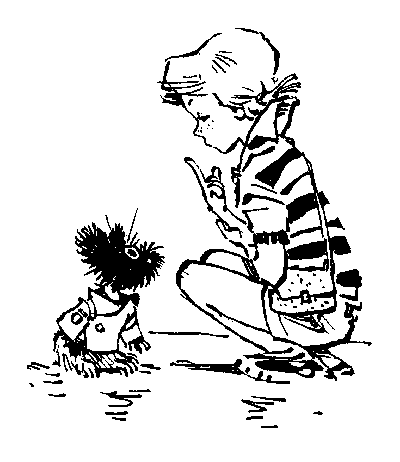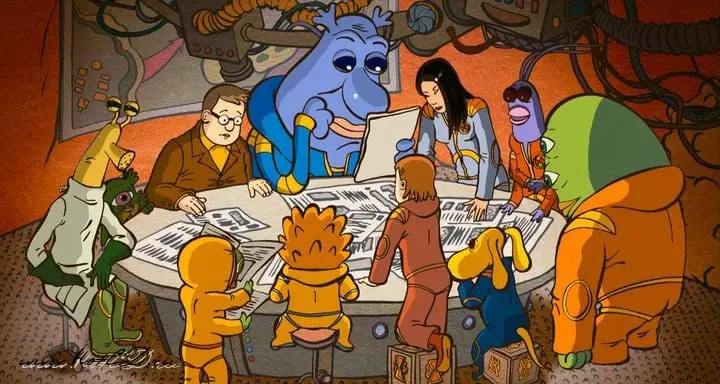There may be several different ways to talk about Alice Selezneva. But I don’t want to be political, and I don’t want to be too analytical. I just want to share with you what a wonderful role model I had when I was a young girl.
In a certain way, Alice Selezneva was for the Soviet (and even post-Soviet) girls something princess Leia was for the girls in the other world. She was a role model, an example to aspire to. A glimpse of a happy future when everyone can be just like her – brave, inventive, passionate and leading. And a girl.
But Alice, unlike Leia, was not a princess. And she was very young; her first great adventure happens when she is still 8 years old, and the last books cover her mid-teens. While Leia is a woman one can wish to become, Alice is a girl one can imitate right now. While Leia is a space mom, Alice is a space sis.

So, Who Is Alice?
Alice is a schoolgirl, living in Moscow somewhen around 2085. She is the only child of professor Seleznev, Cosmo-zoo director, and his wife, an archtect. While her mother is busy building cities on Venus, Alice is left to herself and to the care of an old household droid, who is a bit too old to properly supervise a young adventurous girl.
Later in life she takes a liking to several different professions. She tries herself in xenobiology, which is her father’s field of expertise. She experiences some adventures as a time-traveller, and her best friend is an archeologist. Last but not least, she ponders becoming a space pilot or an Intergalactic Police Agent. All those career paths are open for her, but we the readers don’t know for sure which one would she choose when the time comes.
And that’s great, because this shows the widest variety of choices a girl can have. When you add in the many female characters Alice meets and interacts with—ranging from a space pirate queen to an Intergalactic Police agent to an adventuress turned devoted housewife to a living planet named Penelope—this variety becomes nearly endless.
While she is still young, she seeks adventure willingly; with age comes a bit of wisdom. Alice realizes that adventure is not always fun, and this realization gives the books a somewhat darker turn. Now she understands the human suffering behind those exciting events. Empathy, not pure love for thrill, becomes her driving force from then on.

Her World
Alice lives in the bright future. Her world is surprisingly free from Communist propaganda (well, not so surprisingly, given Kir Bulychov’s political opinions). It is just a vague future Earth, where all people live in a socialist state that provides them all they need in exchange for their hard work. Somewhere in Space different regimes are present; there are evil monarchies, not so evil monarchies, and traditional democratic states.
Space is pestered by space pirates, who are less like traditional pirates and more like international crime syndicates. InterGPol (Intergalactic Police) hunts the pirates—and also evil tyrants and common criminals—and brings them to justice. All the while, common people continue to live, pursuing their small goals. The books are mostly focused on people of science, and scholars. But we have quick glimpses of other people’s lives, be it deckhands, factory workers, or building crews.
Somewhere on backwards planets there oppression, class privilege, and dire poverty still exist, though. Those place fall easy prey to the space pirates and other galactic criminals. But, the interstellar community tries their best to bring those worlds into their circle and uplift them to civilized life.
Diversity?
The world in the books is fairly diverse, well, for the 1960s-90s, when the books were written.
The Humans are represented by a large cast of all genders, races, and nationalities. While the main cast is obviously Russian (and partly Jewish), we meet lots of different people across those books. There are Asian space captains and African scientists, Latinx sea explorers and Arabian biologists. And some of them are also female.
What I liked most as a child reader was that the female cast was usually treated as not Special™. There were scientists and scholars, and some of them were women. Like, their existence alongside the male characters was completely normal and not something out of the ordinary. While there certainly were some tropey depictions and stereotypical characters, those were sad exceptions and not the rule.
(A fun fact: Alice’s missing mom building cities was derived from real life. While Kir Bulychov was looking after their daughter, his wife, an architect, was busy building cities in Soviet Asia.)
Also in a striking difference with most sci-fi books and films, the aliens here were allowed diversity, too. By that I mean there was no Planet of Hats; if some alien race had more than one representative, those could be as different as any two Humans.
General Thoughts
All of this is why I’m sad children in the West don’t have Alice. Those books may be not a pinnacle of fantastic prose, but they are still well-written. And girls still need a heroine to look up to.
Maybe, I was a bit clumsy in my essay, but that’s because it is usually hard to talk about a story your reader is completely alien to (pun intended).
If you’re interested, you can try watching the Visitor from the Future miniseries on YouTube (it’s completely legal under Russian law). The miniseries is much worse when it comes to sexism (they managed to sideline Alice in favor of a boy protagonist), and it’s dated, but it’s still a nice show to watch. Also, there is a great animated movie, considered a cult classic of Soviet sci-fi animation. And it is much better when it comes to Alice’s characterization. Who knows, maybe someone will translate the books!

